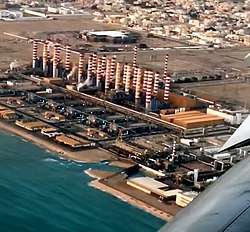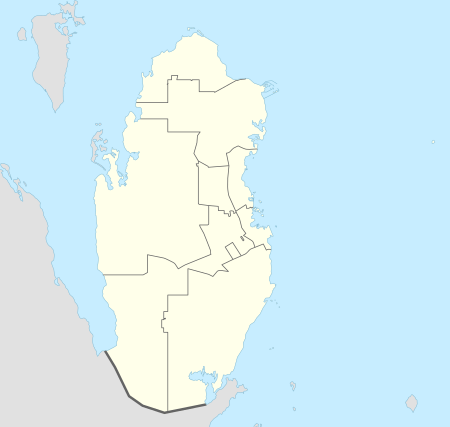Ras Abu Fontas
Ras Abu Fontas (Arabic: راس بو فنطاس) is a coastal industrial area in Doha on the boundary with Al Wakrah Municipality in Qatar.[2] The government has designated the district as a free economic zone starting in 2019.[3]
Ras Abu Fontas راس بو فنطاس | |
|---|---|
District | |
 Aerial shot of power stations in Ras Abu Fontas in 2015 | |
 Ras Abu Fontas | |
| Coordinates: 25.2057°N 51.6163°E | |
| Country | |
| Municipality | Ad-Dawhah |
| Zone | Zone 49 |
| District no. | 636 |
| Area | |
| • Total | 12.9 km2 (5.0 sq mi) |
Geography
In a 2010 survey of Ras Abu Fontas' coastal waters conducted by the Qatar Statistics Authority, it was found that its average depth was 2.75 meters (9 ft 0 in) and its average pH was 7.84. Furthermore, the waters had a salinity of 49.61 psu, an average temperature of 22.51°C and 26.13 mg/L of dissolved oxygen.[4]
Power stations
Ras Abu Fontas A was inaugurated in April 1977 at a cost of QR 2.1 billion. In 1983, its 14 gas turbines had a capacity of 618 MW.[5] As of 2018, this capacity has been lowered to 497 MW.[6]
Ras Abu Fontas B power station was commissioned in the 1990s.[7] Daily capacity is currently 609 MW. After an expansion was announced, Ras Abu Fontas B1 power station was officially opened in July 2001, costing nearly QR 780 million. This added 377 MW to the plant's capacity.[8] Capacity was increased by 567 MW with the addition of Ras Abu Fontas B2.[6]
Desalination plants
In 1981, the Qatari government installed eight desalination units in Ras Abu Fontas A, with each individual unit possessing a daily capacity of 4 million gallons.[5] This capacity was eventually raised to 55 million gallons per day.[6] The introduction of Ras Abu Fontas A1 saw daily capacity increased by 45 million gallons.[6]
Ras Abu Fontas A2 desalination plant was opened in November 2015 after being constructed at a cost of over QR 1.8 billion. It had a daily capacity of 36 million gallons.[9]
In September 2016, Ras Abu Fontas A3 desalination plant became operational, having been opened at a cost of QR 1.75 billion. Capacity was 22 million gallons per day, but after being expanded in April 2017, its capacity was raised to 36 billion gallons per day.[10]
Ras Abu Fontas B and Ras Abu Fontas B2 raised capacity by 33 million and 30 million gallons per day, respectively.[6]
Transport
The elevated Ras Bu Fontas station currently serves the Red Line of the Doha Metro, which runs from Mesaieed in the south to Al Khor in the north.[11][12] As part of the metro's Phase 1, the station was inaugurated on 8 May, 2019, along with all other Red Line stations.[13] It is located on Al Wakrah Road.[14]
Among the station's facilities are a Qatar National Bank ATM, a prayer room and restrooms.[14] There is one metrolink, which is the Doha Metro's feeder bus network, servicing the station:[15]
- M126, which serves Barwa Village.
Another metro station serving the area is the elevated Free Zone station, found on Al Wakrah Road north of the Ras Bu Fontas station. The station has identical facilities to the Ras Bu Fontas station, and has one metro link:[14]
- M140, which serves the Religious Complex in Mesaimeer.
.jpg) Ras Abu Fontas station under construction in 2017.
Ras Abu Fontas station under construction in 2017._(cropped).jpg) Economic Zone station under construction in 2017.
Economic Zone station under construction in 2017.
References
- "District Area Map". Ministry of Development Planning and Statistics. Retrieved 30 November 2019.
- "ACCIONA takes part in the opening ceremony of the construction work for its first desalination plant in Qatar". ACCIONA. 11 December 2015. Retrieved 24 May 2018.
- "Qatar to launch first Free Zone in first quarter of 2019". The Peninsula. 9 October 2018. Retrieved 14 January 2019.
- "Qatar Infrastructure Statistics" (PDF). Qatar Statistics Authority. May 2012. p. 29. Retrieved 18 March 2019.
- Whelan, John (1983). Qatar, a MEED practical guide. London: Middle East Economic Digest. p. 113. ISBN 0950521191.
- "About us". Qatar Electricity and Water Company. Retrieved 24 May 2018.
- "History". Kahramaa. Retrieved 24 May 2018.
- "Ras Abu Fontas B Power Expansion Project Inaugurated". MEES. 15 July 2002. Retrieved 24 May 2018.
- "Ras Abu Fontas (RAF) A2 Seawater Desalination Plant". Water Technology. Retrieved 24 May 2018.
- Ramesh Mathew (18 April 2017). "PM launches expanded RAF A3 water plant". Gulf Times. Retrieved 24 May 2018.
- "Inside Ras Bu Fontas station". Gulf Times. 15 August 2018. Retrieved 29 December 2018.
- "QAR Metro". arcgis.com. Retrieved 17 March 2019.
- Saba Aziz (8 May 2019). "Qatar rolls out first-ever 'landmark' metro for public". Al Jazeera. Retrieved 6 December 2019.
- "Plan My Journey Map". Qatar Rail. Retrieved 6 December 2019.
- "Metrolink". Qatar Rail. Retrieved 6 December 2019.